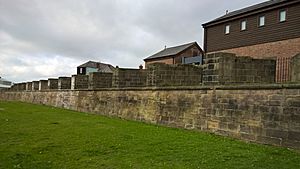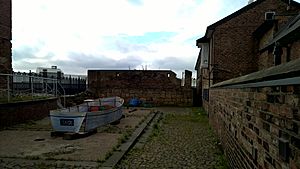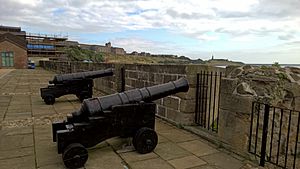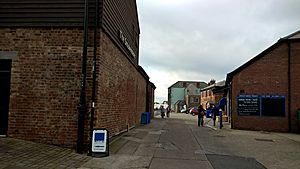Clifford's Fort facts for kids
Clifford's Fort was a strong fort built near the mouth of the River Tyne in the 1600s. It was made to defend against attacks during the Anglo-Dutch Wars, which were wars between England and the Netherlands. Later, it became a place where special underwater bombs, called mines, were stored to protect the river. Today, it is a protected historical site in the old Fish Quay area of North Shields, Tyne and Wear, in North East England.
Contents
History of Clifford's Fort
The Fort in the 1600s
Clifford's Fort was built in 1672. This was at the start of the Third Dutch War. Before this, a simpler fort was on the same spot about 30 years earlier. That first fort was made of "gabions," which are like big baskets filled with sand and stones. Guns were placed between them. But this old fort was destroyed in a battle in 1644.
The new fort was named after Lord Clifford of Chudleigh. He was an important government official at the time. The fort was designed by an engineer named Martin Beckman. It had a raised area with walls and a three-story redoubt (a small, strong fort inside a bigger one). This protected a lower gun battery near the river. On the land side, it had a bastioned trace, which means the walls had pointy parts sticking out for better defense. When it was first built, it had 30 cannons.
From the very beginning, Clifford's Fort worked with the nearby defenses of Tynemouth Castle. The Governor of Tynemouth Castle was in charge of the fort until 1839. By the time Clifford's Fort was built, the castle was falling apart. So, the fort became the main defense for the River Tyne.
Building the fort caused problems for a lighthouse that was already there. This lighthouse had been built by Trinity House of Newcastle-upon-Tyne in 1539. The fort's guns were so powerful that when they fired, they even damaged the lighthouse lantern!
The Fort in the 1700s
In the 1700s, many parts of the fort were rebuilt. The strong stone walls facing the sea that you see today are from that time. By 1720, the redoubt had been changed into a barracks (living quarters) for "Invalids." These were military veterans who were injured or older. They helped to operate the cannons. There was also a gunpowder magazine (a place to store gunpowder) in the basement.
The fort was kept in good condition. However, a new Governor's House was built in 1726. This building blocked the view of the old Low Light (a type of lighthouse). So, the Low Light had to be rebuilt the next year. In 1748, reports said the fort had "thirty-six 18-pounder guns" and a lot of gunpowder.
The Fort in the 1800s
Clifford's Fort continued to be used as a gun battery until the late 1800s. But then, the Tynemouth piers were built. These long structures stretched out into the sea and made the fort less important for defense. The fort was emptied in 1881.
However, in 1888, the fort became the main base for a new group called the Tyne Division Royal Engineers (Volunteers) Submarine Miners. This group was one of many around the country that laid and looked after special underwater mines. These mines were used to protect ports. They were set off remotely using underwater cables. The cables were stored in three large tanks next to the fort's eastern wall. Several new buildings were added to the site at this time. The old tower, or 'keep,' was pulled down in 1893. Around 1900, two fast-firing 6-pounder guns were put in place to protect the minefield.
The Fort in the 1900s
In 1907, the job of handling mines was moved from the Royal Engineers to the Royal Navy. So, protecting ports with submarine mines was stopped for a while. (But it was started again during the First World War). The volunteers at Clifford's Fort were then renamed the Tyne Electrical Engineers. Their new job was to look after searchlights for coastal defense.
The Electrical Engineers moved out of the fort in 1928. After that, the fort was no longer a military place. The local government bought it. It was then used as a fish processing plant. Some of the buildings from the submarine mining time were changed. The mine storage buildings and a barracks became smokehouses for fish.
The fort kept working as part of the Fish Quay throughout the 1900s. But over time, some of its old parts were damaged. Some of the fort's walls were pulled down as new buildings were added or made bigger. The house of the Master Gunner (the main person in charge of the cannons) was at the southwest corner. It was built in the mid-1700s but was pulled down in 1973 to make way for a new fish processing unit.
Clifford's Fort Today
Starting in 2008, the remains of the fort were fully restored. Many newer buildings were removed, and the moat (a ditch around the fort) was put back. In 2013, the fort was taken off the Heritage at Risk Register. This happened after a £1 million project. This project was paid for by North Tyneside Council and the Heritage Lottery Fund. It finished restoring the fort and brought unused buildings back to life. This included the Old Low Light, which opened to the public in 2015 as a museum. The museum tells the story of the fort and the area.
Images for kids






